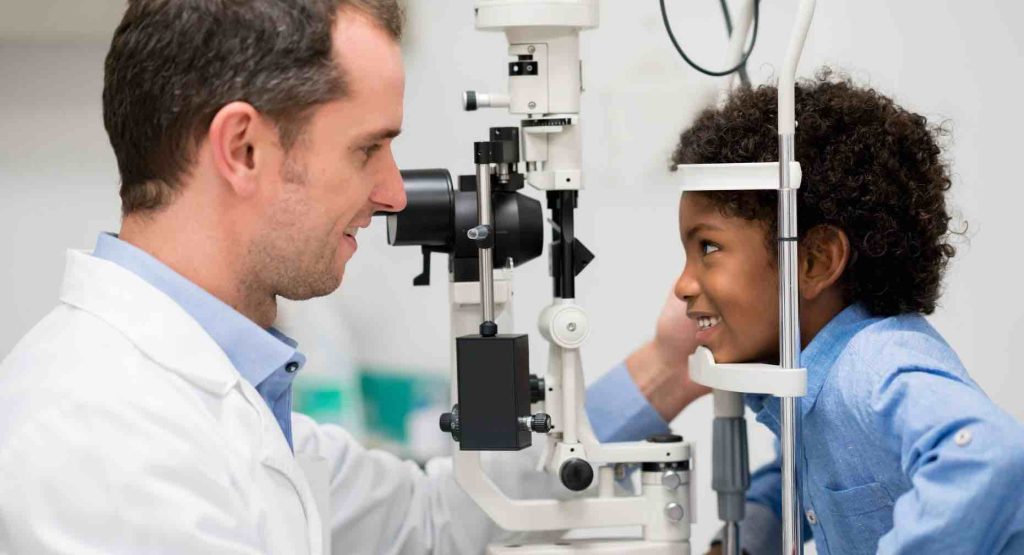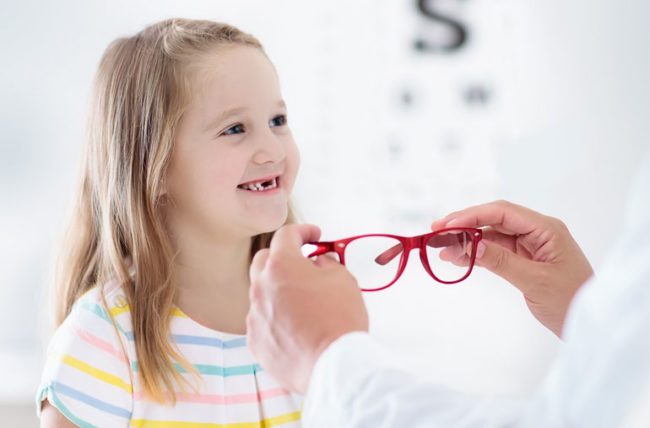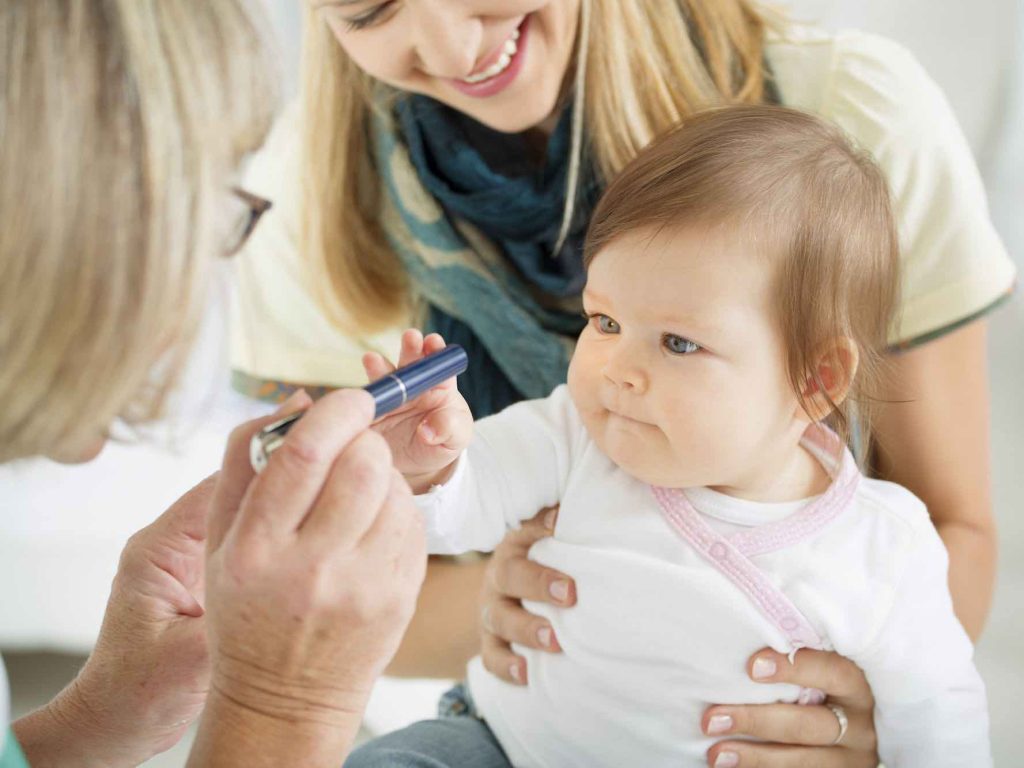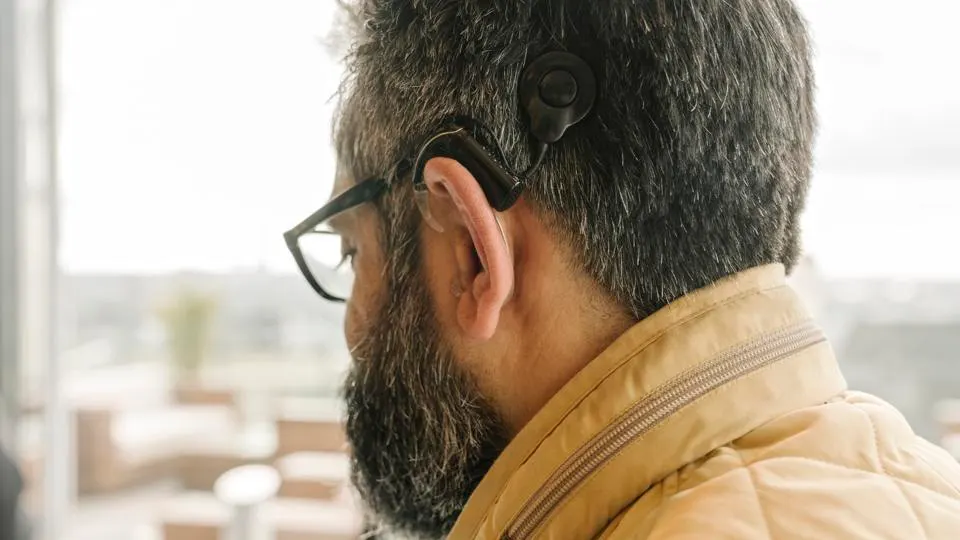Eye Exams for Children
As parents we all want to support our kids through a healthy childhood. This will include many trips to the pediatrician for immunizations, check-ups and a fever or two. What may come as a surprise is that your child’s regular medical appointments should include visits to the eye doctor. Even when your little one is at a tender age.
In fact, healthy eyes are essential to hitting a host of cognitive, social, and physical developmental milestones. Good sight can help children meet their full aptitude in academics, social situations, sports, and other hobbies.

How Often Should Kids Get Eye Exams?
Children should have their first comprehensive eye exam at 6 months of age.
They then should have their eyes examined at age 3 and just before they enter the first grade — at about age 5 or 6.
School-aged children should have an eye exam at least every two years if no vision correction is required. Children who need eyeglasses or contact lenses should be examined annually or as recommended by your eye doctor.
Why Are Eye Exams Important for Kids?
It is not uncommon for sight impairments in schoolchildren to have roots in a younger age, even in infancy. As your child grows, their brain learns to use their eyes to see. Just as they learn to use their legs to stand or their hands to refine motor skills. Vision irregularities during early eye and brain development can be a trigger for a lifetime of poor eyesight and vision-related learning difficulties. As with most ailments, when detected early you are able to prevent eyesight issues.
When scheduling an eye exam for your child, it’s a good idea to choose a time of day when they are attentive. It’ll make it easier on you while there, and more likely that your kid will want to come back to our office next time.

Parents should discuss certain aspects of your family medical history relating to sight. Also, be sure to tell your doctor about any problems you have noticed with your child’s vision or related behaviors, such as if your child has:
- Excessive blinking
- Frequent eye rubbing
- Difficulty maintaining eye contact
- Poor eye tracking abilities
- Inability to maintain a gaze on objects
- Delayed motor development
Working with the right doctor, you can improve the chances that your little one will have quality sight throughout childhood. Along with all the benefits relating to learning, growing, and socializing that seeing well entails.
Infant Eye Exams
Taking your infant to the eye doctor when they are only a half year into their life may seem a little early. There is an excellent reason for it: your baby’s visual acuity begins to sharpen at 6 months.
Until this age, infants can only see objects in high contrast and within about a foot of their face. An examination at 6 months with an eye doctor will ensure that your child’s eyes are developing and working in tandem.
Your family doctor or pediatrician may perform this eye exam, but they are not as well trained as eye specialists. An ophthalmologist or optometrist are best equipped to give the thorough evaluation.
Your eye doctor will test the following visual skills in your 6-month-old:
- Fixation – by 6 months of age, your child should be able to visually lock on an object and follow it. Soon after birth, an infant should be able to fixate on an object. By 3 months old, a baby should have the ability to visually follow an object.
- Pupil responsiveness – your doctor will determine whether your baby’s pupils open and close in the absence or presence of light.
- Detection acuity – this test may involve cards that have stripes on one side to attract the gaze of your infant.

Preschool Eye Exams
Preschoolers are little sponges, taking in the world and growing by leaps and bounds. Their vision guides the multitude of their learning experiences. During those pre-kindergarten years (ages 2 to 5), a child will hone the visual abilities gained during infancy. All while developing new ones too. An eye exam at about 3 years old, and again a couple of years later before kindergarten, is key to keeping your child on the path towards optimal eye health.
These pre-K exams will detect If your child has difficulty seeing. Whether due to nearsightedness, farsightedness, or astigmatism. An evaluation will also take place for other common visual problems like:
- Eye misalignment – also known as strabismus, crossed or misaligned eyes is caused by underlying problem such as improper muscle control. Strabismus is a common cause of lazy eye and it is important to treat as early as possible to facilitate eye teaming skills.
- Lazy eye – this is when one eye does not have the same visual acuity as the other eye. Amblyopia is best treated at a young age as it cannot always be overcome with eyeglasses or contact lenses. Eye drops or a patch may aid to improve the health of the weaker eye.
- Convergence insufficiency – your eye doctor will assess the ability of your child’s eyes to converge and focus on a nearby object for a length of time. This skill is particularly important for reading.
- Anterior eye health – your doctor will examine your child’s iris, cornea, and lens. They check for structural irregularities or cloudiness. Your doctor will examine your child’s eyelids for abnormalities like eyelash follicles, bumps, inflammation, and discharge.
It’s not a problem if your little one doesn’t have the alphabet under their belt. There are ways to test for visual acuity that don’t involve the alphabetized vision test. LEA symbols swap out letters for identifiable symbols like a house, apple, triangle, or circle, and are often used on young children, making it easy for them to explain what it is they see. In addition to taking a visual acuity test, your child may have the following tests performed:
- Random dot stereopsis – your kid will love this one. They get to wear 3D glasses and stare at a pattern of dots. For them it’s a fun game, while we measure how well your child’s eyes work together.
- Retinoscopy – this test involves shining a light into the eye to observe the reflection from the retina and if there is a refractive error. It determines a corrective lens prescription.
Children’s Eye Exams
Your child is busy in elementary school! While learning arithmetic and expanding their vocabulary, vision tests are as needed as ever. Vision acuity can change quickly. Solid visual skills are paramount to your child performing well academically. For example, a child who cannot view a blackboard or see print easily can become frustrated. They think they are not smart enough to perform reading or mathematical tasks which can result in a decline in school performance.
We recommend an eye exam for school kids every two years if they don’t need vision correction. Children who wear eyeglasses or contact lenses should plan to have an examination annually, or in some cases more frequent depending on the recommendation by your pediatric ophthalmologist.
Common Pediatric Eye Conditions
In addition to detecting more routine vision problems, such as myopia (nearsightedness), hyperopia (farsightedness), and astigmatism (abnormal curvature of the cornea), comprehensive eye examinations check for common childhood conditions such as:
- Amblyopia (lazy eye)
- Strabismus (crossed eyes)
- Glaucoma
- Cataracts
These conditions are often present at birth as a result of genetic factors, and should be treated early to reduce the risk of complications. Treatment may include glasses to improve focus, eye exercises to correct improper vision habits, eye patches for amblyopia, or eye drops for dryness, inflammation, or infection.
Diagnostic Tests Used in a Pediatric Eye Examination
The child’s vision may be assessed using the traditional eye charts for near and distant vision, or special charts for young children, using pictures instead of letters. Other tests that may be administered include:
- A visual field test
- Dilation
- Slit-lamp examination
- Cover test
- Retinoscopy
- Refraction
Each test is designed to test either visual acuity or the health of various parts of the eye. Using these tests, the ophthalmologist is able to assess whether corrective lenses are necessary to improve vision or whether there is any eye disease or underlying condition that requires treatment.
After a Pediatric Eye Examination
After the eye examination, most children do not require any further treatment. For those for whom a diagnosis is made, a treatment plan will be developed that may include:
- Prescription for eyeglasses
- Recommendation that sunglasses be worn
- Medication for inflammation or infection
- Wearing a patch on the more functional eye (for amblyopia)
- Vision therapy for weak eye muscles
- Surgical repair (rarely)
Eye examinations are important because they can detect underlying conditions that the child and parents may not be aware of, catching the problems at an early stage so they can be effectively treated before any damage to vision occurs. Such examinations can also test for dyslexia and other disabilities that may affect the child’s ability to learn and perform well in school. Children with dyslexia have trouble visually processing letters and must work harder than other children to read. Such children usually require some early intervention so they do not fall behind their peers.
Ophthalmologists usually recommend that children wear sunglasses with UV protection when exposed to sunlight. This will help to keep their eyes from developing certain eye diseases, like cataracts and macular degeneration, later in life. Such eye protection also prevents photokeratitis (snow blindness), skin cancer on the eyelids, and pterygium, non-cancerous growths in the eye that may block vision and require removal.
While all children’s eyes are screened shortly after birth, parents should make sure that their children have regular eye check-ups as they grow to ensure ongoing eye health and proper vision.
Contact SightMD today to schedule an appointment with one of our doctors to discuss your child’s vision health at one of our convenient locations!

Healthy Diet and Cataracts
The Role of a Healthy Diet in Preventing Cataracts As we age, various eye conditions can develop that impact…

Benefits of Cochlear Implants
Understanding the Benefits of Cochlear Implants Hearing loss can significantly impact one’s quality of life, making communication and connection…

Long-Term Considerations for Individuals with Cataracts
What to consider Long-Term for Individuals with Cataracts As we age, our eyes undergo various changes, and one common…